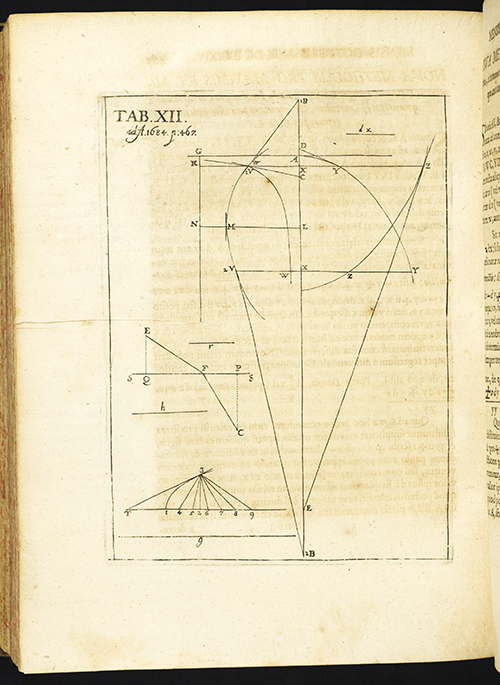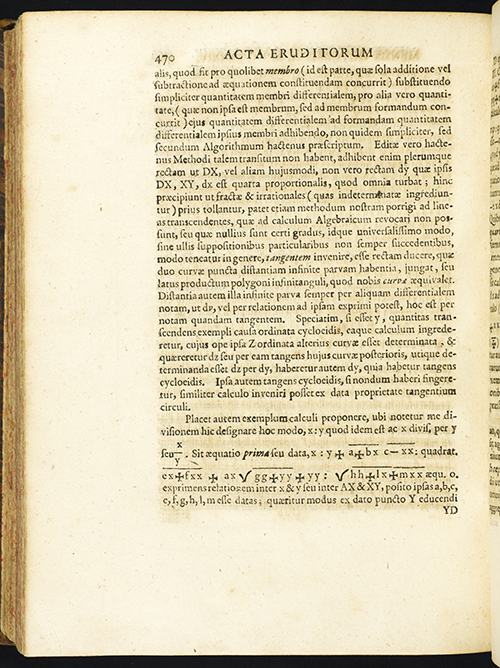- About MAA
- Membership
- MAA Publications
- Periodicals
- Blogs
- MAA Book Series
- MAA Press (an imprint of the AMS)
- MAA Notes
- MAA Reviews
- Mathematical Communication
- Information for Libraries
- Author Resources
- Advertise with MAA
- Meetings
- Competitions
- Programs
- Communities
- MAA Sections
- SIGMAA
- MAA Connect
- Students
- MAA Awards
- Awards Booklets
- Writing Awards
- Teaching Awards
- Service Awards
- Research Awards
- Lecture Awards
- Putnam Competition Individual and Team Winners
- D. E. Shaw Group AMC 8 Awards & Certificates
- Maryam Mirzakhani AMC 10 A Awards & Certificates
- Two Sigma AMC 10 B Awards & Certificates
- Jane Street AMC 12 A Awards & Certificates
- Akamai AMC 12 B Awards & Certificates
- High School Teachers
- News
You are here
Mathematical Treasure: Leibniz's Papers on Calculus - Differential Calculus

Above is the title page for the 1684 volume of Acta Eruditorum.

The first page of the October 1684 issue (number X) of Acta Eruditorum is shown above. Leibniz's first article describing the Calculus appeared on pages 467-473 of this issue.

A plate of diagrams for Leibniz's article on the Calculus was placed opposite page 467, the first page of the article. The reader is referred to it in the very first line of the article: note "TAB.XII," or Table XII, in the righthand margin of page 467, below.

Leibniz’s first article describing the Calculus was published in October, 1684. The article, “Nova methodus pro maximis et minimis, itemque tangentibus,…, & singulare pro illis calculi genus” [“New method for the maximum and minimum, and also tangents, …, and a singular type of calculus for them”], was a definitive exposition of his differential calculus. The adjective "singulare" is often translated as "remarkable": "a remarkable type of calculus for them." The initials "G.G.L." are for Gottfried Wilhelm Leibniz with Wilhelm latinized to Guilielmus.
Do you recognize the product and quotient rules for differentials in the second paragraph above? It helps to know that "aequ." is used for "equals" or "=". The equals sign, =, is used in Leibniz's articles from 1686 and 1693 on the next two pages.
The remainder of the article is presented below in its entirety. A translation of the article from Latin to English can be found in D. J. Struik's A Source Book in Mathematics (1200-1800), pp. 271-280.


On the page above (page 469), Leibniz discussed differentials of powers (potentiae) and of radicals (radices). He also named the methods discussed in his article "differential calculus": see "calculi hujus, quem voco differentialem," or "this calculus, which I call differential" at the start of the last paragraph.




The images above are used through the courtesy of the Lilly Library, Indiana University, Bloomington, Indiana. You may use them in your classroom; for all other purposes, please seek permission from the Lilly Library.
Reference
D. J. Struik (editor), A Source Book in Mathematics (1200-1800), Harvard University Press, Cambridge, Mass., 1969.
Frank J. Swetz (The Pennsylvania State University), "Mathematical Treasure: Leibniz's Papers on Calculus - Differential Calculus," Convergence (June 2015)




